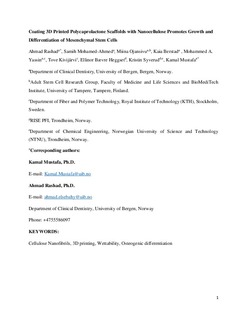| dc.contributor.author | Elsebahy, Ahmad Rashad Saad Mohamed | |
| dc.contributor.author | Mohamed-Ahmed, Samih | |
| dc.contributor.author | Ojansivu, Miina | |
| dc.contributor.author | Berstad, Kaia | |
| dc.contributor.author | Yassin, Mohammed Ahmed | |
| dc.contributor.author | Kivijärvi, Tove | |
| dc.contributor.author | Heggset, Ellinor Bævre | |
| dc.contributor.author | Syverud, Kristin | |
| dc.contributor.author | Mustafa, Kamal Babikeir Eln | |
| dc.date.accessioned | 2019-03-14T13:05:33Z | |
| dc.date.available | 2019-03-14T13:05:33Z | |
| dc.date.created | 2018-12-17T10:09:17Z | |
| dc.date.issued | 2018 | |
| dc.identifier.citation | Biomacromolecules. 2018, 19 (11), 4307-4319. | nb_NO |
| dc.identifier.issn | 1525-7797 | |
| dc.identifier.uri | http://hdl.handle.net/11250/2590058 | |
| dc.description.abstract | 3D printed polycaprolactone (PCL) has potential as a scaffold for bone tissue engineering, but the hydrophobic surface may hinder optimal cell responses. The surface properties can be improved by coating the scaffold with cellulose nanofibrils material (CNF), a multiscale hydrophilic biocompatible biomaterial derived from wood. In this study, human bone marrow-derived mesenchymal stem cells were cultured on tissue culture plates (TCP) and 3D printed PCL scaffolds coated with CNF. Cellular responses to the surfaces (viability, attachment, proliferation, and osteogenic differentiation) were documented. CNF significantly enhanced the hydrophilic properties of PCL scaffolds and promoted protein adsorption. Live/dead staining and lactate dehydrogenase release assays confirmed that CNF did not inhibit cellular viability. The CNF between the 3D printed PCL strands and pores acted as a hydrophilic barrier, enhancing cell seeding efficiency, and proliferation. CNF supported the formation of a well-organized actin cytoskeleton and cellular production of vinculin protein on the surfaces of TCP and PCL scaffolds. Moreover, CNF-coated surfaces enhanced not only alkaline phosphatase activity, but also collagen Type-I and mineral formation. It is concluded that CNF coating enhances cell attachment, proliferation, and osteogenic differentiation and has the potential to improve the performance of 3D printed PCL scaffolds for bone tissue engineering. | nb_NO |
| dc.language.iso | eng | nb_NO |
| dc.publisher | ACS Publications | nb_NO |
| dc.title | Coating 3D Printed Polycaprolactone Scaffolds with Nanocellulose Promotes Growth and Differentiation of Mesenchymal Stem Cells | nb_NO |
| dc.type | Journal article | nb_NO |
| dc.type | Peer reviewed | nb_NO |
| dc.description.version | acceptedVersion | nb_NO |
| dc.source.pagenumber | 4307-4319 | nb_NO |
| dc.source.volume | 19 | nb_NO |
| dc.source.journal | Biomacromolecules | nb_NO |
| dc.source.issue | 11 | nb_NO |
| dc.identifier.doi | 10.1021/acs.biomac.8b01194 | |
| dc.identifier.cristin | 1643883 | |
| dc.description.localcode | © American Chemical Society 2018. This is the authors accepted and refereed manuscript to the article. Locked until 9 October 2019 due to copyright restrictions. | nb_NO |
| cristin.unitcode | 194,66,30,0 | |
| cristin.unitname | Institutt for kjemisk prosessteknologi | |
| cristin.ispublished | true | |
| cristin.fulltext | original | |
| cristin.fulltext | postprint | |
| cristin.qualitycode | 1 | |
